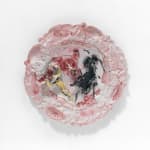
Lucio Fontana Argentine-Italian, 1899-1968
Further images
Fontana learned his father's trade as a sculptor of graveyard memorials and his early sculptural works were reflective of this traditional and figurative influence. By the time World War II was over, Fontana's polychrome ceramics had reached the peak of baroque exuberance.
Fontana moved back to his birthplace of Argentina and lived in Buenos Aires from 1940-47; 1946 was the year he published his 'Manifeso Blanco' and in 1947 he signed the 'Primo Manifesto dello Spazialismo". Upon his return to Italy, he resumed his ceramic work in Albisola. This highly ornate bullfight is part of a series of battle scenes that Fontana created from 1947 onwards using different supports, such as plates and vases, and also executed in free-standing sculptural form, which evoke the representations of warriors and soldiers on horseback, armed with lances and spears. In 1950, Fontana visited Pablo Picasso's studio in Vallauris, France, and was surprised to see not only how prolific his ceramic production was, but that he based his work on the forms of ancient vases and plates. After this trip, Fontana obtained a series of molds from an abandoned furnace of eighteenth-century plates in the 'Vecchia Savona' style and used them as the basis for his series of 'Battaglie' (battles) and 'Corride' (bullfights). At the time, these ceramics were described by Leonardo Borghese as "halfway between Impressionism and Rococo." The bullfight scene depicted on the large ornamental plate in Corrida (1948-1950) depicts vigorously molded figures with a strong pictorial appearance, immensely tactile and full of expressive energy.
